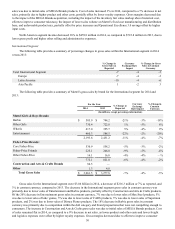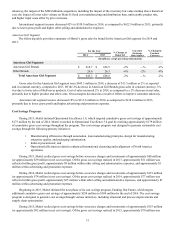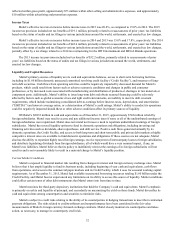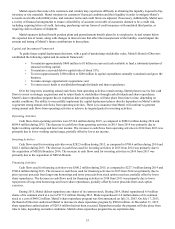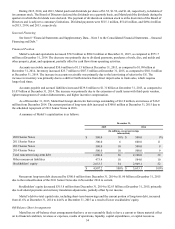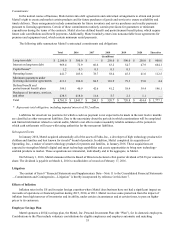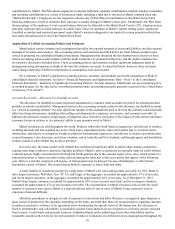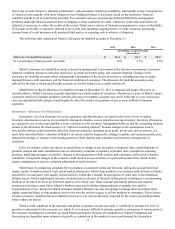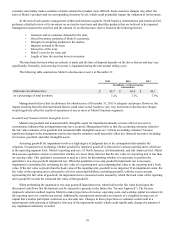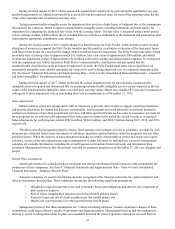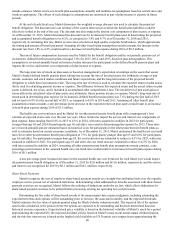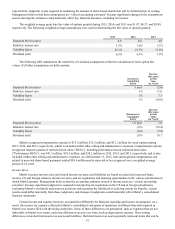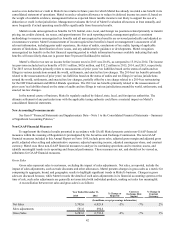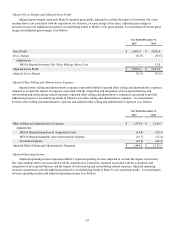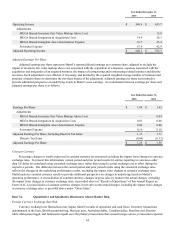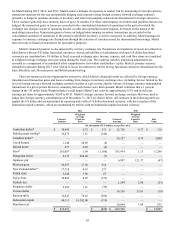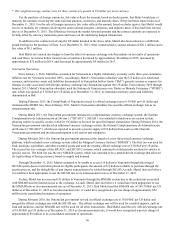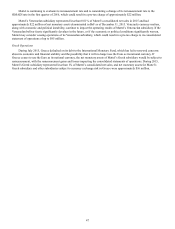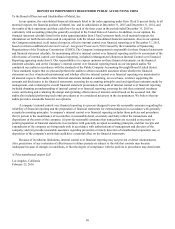Mattel 2015 Annual Report Download - page 44
Download and view the complete annual report
Please find page 44 of the 2015 Mattel annual report below. You can navigate through the pages in the report by either clicking on the pages listed below, or by using the keyword search tool below to find specific information within the annual report.40
outside actuaries. Mattel reviews its benefit plan assumptions annually and modifies its assumptions based on current rates and
trends as appropriate. The effects of such changes in assumptions are amortized as part of plan income or expense in future
periods.
At the end of each fiscal year, Mattel determines the weighted average discount rate used to calculate the projected
benefit obligation. The discount rate is an estimate of the current interest rate at which the benefit plan liabilities could be
effectively settled at the end of the year. The discount rate also impacts the interest cost component of plan income or expense.
As of December 31, 2015, Mattel determined the discount rate for its domestic benefit plans used in determining the projected
and accumulated benefit obligations to be 4.2%, as compared to 3.8% and 4.7% as of December 31, 2014 and 2013,
respectively. In estimating this rate, Mattel reviews rates of return on high-quality corporate bond indices, which approximate
the timing and amount of benefit payments. Assuming all other benefit plan assumptions remain constant, the increase in the
discount rate from 3.8% to 4.2% would result in a decrease in benefit plan expense during 2016 of $0.2 million.
The rate of future compensation increases used by Mattel for the benefit obligation and the net periodic pension cost of
its domestic defined benefit pension plans averaged 3.8% for 2015, 2014, and 2013, based on plan demographics. This
assumption is reviewed annually based on historical salary increases for participants in the defined benefit pension plans and
impacts the service and interest cost components of plan income or expense.
The long-term rate of return on plan assets is based on management’s expectation of earnings on the assets that secure
Mattel’s funded defined benefit pension plans, taking into account the mix of invested assets, the arithmetic average of past
returns, economic and stock market conditions and future expectations, and the long-term nature of the projected benefit
obligation to which these investments relate. The long-term rate of return is used to calculate the expected return on plan assets
that is used in calculating pension income or expense. The difference between this expected return and the actual return on plan
assets is deferred, net of tax, and is included in accumulated other comprehensive loss. The net deferral of past asset gains or
losses affects the calculated value of plan assets and, ultimately, future pension income or expense. Mattel’s long-term rate of
return used in determining plan expense for its domestic defined benefit pension plans was 7.5% during the first half of 2015
and revised to 6.8% for the second half of 2015, as compared to 8.0% in 2014 and 2013. Assuming all other benefit plan
assumptions remain constant, a one percentage point decrease in the expected return on plan assets would result in an increase
in benefit plan expense during 2016 of $3.5 million.
The health care cost trend rates used by Mattel for its other postretirement benefit plans reflect management’s best
estimate of expected claim costs over the next ten years. These trend rates impact the service and interest cost components of
plan expense. Rates ranging from 8.8% in 2015 to 4.5% in 2024, with rates assumed to stabilize in 2023 for participants
younger than age 65 and 2024 for participants age 65 and older, were used in determining plan expense for 2015. These rates
are reviewed annually and are estimated based on historical costs for participants in the other postretirement benefit plans as
well as estimates based on current economic conditions. As of December 31, 2015, Mattel maintained the health care cost trend
rates for its other postretirement benefit plan obligation at 7.5% for participants younger than age 65 and 8.8% for participants
age 65 and older. For participants younger than age 65, the cost trend rates are estimated to reduce to 4.5% by 2023, with rates
assumed to stabilize in 2023. For participants age 65 and older, the cost trend rates are estimated to reduce to 4.5% by 2024,
with rates assumed to stabilize in 2024. Assuming all other postretirement benefit plan assumptions remain constant, a one
percentage point increase in the assumed health care cost trend rates would result in an increase in benefit plan expense during
2016 of $0.1 million.
A one percentage point increase/(decrease) in the assumed health care cost trend rate for each future year would impact
the postretirement benefit obligation as of December 31, 2015 by $2.0 million and $(1.6) million, respectively, and the service
and interest cost recognized for 2015 by $0.1 million and $(0.1) million, respectively.
Share-Based Payments
Mattel recognizes the cost of employee share-based payment awards on a straight-line attribution basis over the requisite
employee service period, net of estimated forfeitures. In determining when additional tax benefits associated with share-based
payment exercises are recognized, Mattel follows the ordering of deductions under the tax law, which allows deductions for
share-based payment exercises to be utilized before previously existing net operating loss carryforwards.
Determining the fair value of share-based awards at the measurement date requires judgment, including estimating the
expected term that stock options will be outstanding prior to exercise, the associated volatility, and the expected dividends.
Mattel estimates the fair value of options granted using the Black-Scholes valuation model. The expected life of the options
used in this calculation is the period of time the options are expected to be outstanding and has been determined based on
historical exercise experience. Expected stock price volatility is based on the historical volatility of Mattel’s stock for a period
approximating the expected life, the expected dividend yield is based on Mattel’s most recent actual annual dividend payout,
and the risk-free interest rate is based on the implied yield available on US Treasury zero-coupon issues approximating the


